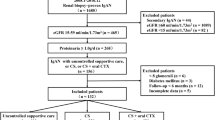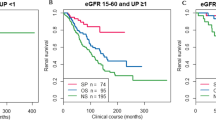Abstract
Background
The specific treatment regimens of IgA nephropathy (IgAN) patients with moderate proteinuria (1.0–3.5 g/day) remain controversial. The purpose of this study was to explore the optimized therapeutic regimen for IgAN patients through analyzing the clinical data.
Methods
A retrospective study was conducted, 449 patients with biopsy-proven IgAN were enrolled. Patients were divided into three groups according to proteinuria levels: urine protein 1.0–1.5 g/day (UP1, n = 111), urine protein 1.5–2.5 g/day (UP2, n = 213), urine protein 2.5–3.5 g/day (UP3, n = 125). Clinical pathological features, treatment regimens and renal outcome were compared. Responses to therapy included complete remission (CR), partial remission (PR), no response (NR) and end-stage renal disease (ESRD). The composite endpoints of renal outcome were defined as 50% decline in eGFR and/or progressing into end-stage renal disease.
Results
During the average follow-up of 44.27 months, 71 (63.9%), 150 (70.4%) and 68 (54.4%) patients achieved CR + PR among three groups, respectively. Whereas 15 (13.5%), 28 (13.1%) and 39 (31.2%) patients progressed to the primary endpoint (P < 0.001). Patients who received corticosteroids (CS) treatment had better remission rate than those with supportive care (SC) or combined corticosteroid plus immunosuppressant (CS + IT) therapy (P < 0.05). Kaplan–Meier survival analysis revealed that patients received CS and CS + IT treatments had better renal prognosis compared with SC therapy in UP2 and UP3 groups (P < 0.05). However, no statistical difference was found among three treatment regimens in UP1 group (P = 0.358).
Conclusion
Corticosteroids therapy might better improve renal prognosis compared with supportive care alone or corticosteroids plus immunosuppressant in IgAN patients with moderate proteinuria (1.5–3.5 g/day).





Similar content being viewed by others
References
Kim JK, Kim JH, Lee SC, Kang EW, Chang TI, Moon SJ et al (2012) Clinical features and outcomes of IgA nephropathy with nephrotic syndrome. CJASN 7(3):427–436
Rodrigues JC, Haas M, Reich HN (2017) IgA nephropathy. Clin J Am Soc Nephrol 12(4):677–686
Coppo R (2017) Corticosteroids in IgA nephropathy: lessons from recent studies. J Am Soc Nephrol 28:25–33
Reich HN, Troyanov S, Scholey JW, Cattran DC, Registry TG (2007) Remission of proteinuria improves prognosis in IgA nephropathy. J Am Soc Nephrol 18(12):3177–3183
Radhakrishnan J, Cattran DC (2012) The KDIGO practice guideline on glomerulonephritis: reading between the (guide)lines—application to the individual patient. Kidney Int 82(8):840–856
Pozzi C, Andrulli S, Del Vecchio L, Melis P, Fogazzi GB, Altieri P et al (2004) Corticosteroid effectiveness in IgA nephropathy: long-term results of a randomized, controlled trial. J Am Soc Nephrol 15(1):157–163
Tesar V, Troyanov S, Bellur S, Verhave JC, Cook HT, Feehally J et al (2015) Corticosteroids in IgA nephropathy: a retrospective analysis from the VALIGA study. J Am Soc Nephrol 26(9):2248–2258
Han X, Xiao Y, Tang Y, Zheng X, Anwar M, Qin W (2019) Clinical and pathological features of immunoglobulin A nephropathy patients with nephrotic syndrome. Clin Exp Med 19(4):479–486
Levey AS, Stevens LA, Schmid CH, Zhang YL, Castro AF 3rd, Feldman HI et al (2009) A new equation to estimate glomerular filtration rate. Ann Intern Med 150(9):604–612
Working Group of the International IgA Nephropathy Network, and the Renal Pathology Society, Roberts IS, Cook HT, Troyanov S, Alpers CE, Amore A et al (2009) The Oxford classification of IgA nephropathy: rationale, clinicopathological correlations, and classification. Kidney Int 76(5):534–545
An L, Tang Y, Peng W, Mathew BS, Qin W (2018) Combined immunosuppressive treatment may improve short-term renal outcomes in Chinese patients with advanced IgA nephropathy. Kidney Blood Press Res 43(4):1333–1343
Lv J, Xu D, Perkovic V, Ma X, Johnson DW, Woodward M et al (2012) Corticosteroid therapy in IgA nephropathy. J Am Soc Nephrol 23:1108–1116
Zhang Y, Luo J, Hu B, Ma T (2018) Efficacy and safety of tacrolimus combined with glucocorticoid treatment for IgA nephropathy: a meta-analysis. J Int Med Res 46(8):3236–3250
Coppo R, Troyanov S, Bellur S, Cattran D, Cook HT, Feehally J et al (2014) Validation of the Oxford classification of IgA nephropathy in cohorts with different presentations and treatments. Kidney Int 86:828–836
Rauen T, Eitner F, Hertig A (2015) Intensive supportive care plus immunosuppression in IgA nephropathy. N ENGl JMED 373(23):2225–2236
Lv J, Zhang H, Wong MG, Jardine MJ, Hladunewich M, Jha V et al (2017) Effect of oral methylprednisolone on clinical outcomes in patients with IgA nephropathy: the TESTING randomized clinical trial. JAMA 318:432–442
Sarcina C, Tinelli C, Ferrario F, Pani A, De Silvestri A, Scaini P et al (2016) Changes in proteinuria and side effects of corticosteroids alone or in combination with azathioprine at different stages of IgA nephropathy. Clin J Am Soc Nephrol 11(6):973–981
Thompson A, Carroll K, Inker L, Floege J, Perkovic V, Boyer-Suavet S et al (2019) Proteinuria reduction as a surrogate end point in trials of IgA nephropathy. Clin J Am Soc Nephrol 14(3):469–481
Inker LA, Mondal H, Greene T, Masaschi T, Locatelli F, Schena FP et al (2016) Early change in urine protein as a surrogate end point in studies of IgA nephropathy: an individual-patient meta-analysis. Am J Kidney Dis 68(3):392–401
Ai Z, Xu R, Liu W, Zhou Q, Li B, Huang F et al (2016) Clinicopathologic features of IgA nephropathy patients with different levels of proteinuria. Clin Nephrol 86(7):35–41
Zhu X, Li H, Liu Y, You J, Qu Z, Yuan S et al (2017) Tubular atrophy/interstitial fibrosis scores of Oxford classification combinded with proteinuria level at biopsy provides earlier risk prediction in lgA nephropathy. Sci Rep 7(1):1100
Author information
Authors and Affiliations
Corresponding author
Ethics declarations
Conflict of interest
The authors declare that they have no conflict of interest with respect to the research.
Ethical approval
The research was in compliance with the Declaration of Helsinki and was approved by the ethical committees of West China Hospital of Sichuan University.
Informed consent
Written informed consents were signed by all the patients.
Additional information
Publisher's Note
Springer Nature remains neutral with regard to jurisdictional claims in published maps and institutional affiliations.
Rights and permissions
About this article
Cite this article
Zhong, Z., Tang, Y., Tan, J. et al. Corticosteroids could improve the renal outcome of IgA nephropathy with moderate proteinuria. Int Urol Nephrol 53, 121–127 (2021). https://doi.org/10.1007/s11255-020-02644-2
Received:
Accepted:
Published:
Issue Date:
DOI: https://doi.org/10.1007/s11255-020-02644-2




